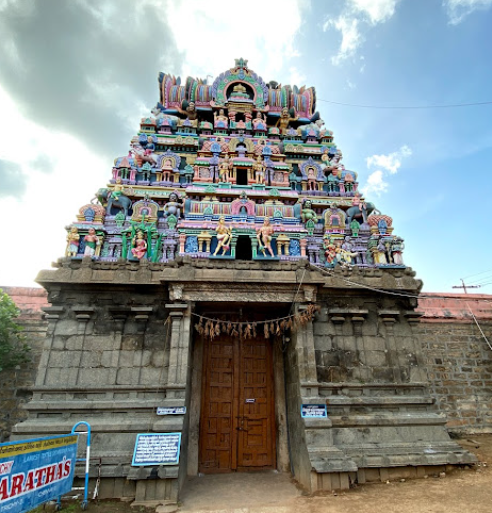Before their marriages, seven virgins known as the Saptha Kannikas—Brahmi, Maheswari, Gaumari, Vaishnavi, Varahi, Indrani, and Chamundi—came to this temple seeking the darshan of Mother Ambica. The goddess appeared before them and promised that they would marry well and live happily. She also granted them the boon to remain in the form of plantain trees in the temple, where they could continue to experience Her presence. Consequently, these virgins are said to have taken the form of plantain trees in the temple, enjoying Her darshan. Lord Shiva also graced the place in the form of a Linga.
Puranic Significance :
This ancient temple, located on the northern bank of the Kollidam River, spans 12 acres. Its main tower, believed to have been built by King Konerinmai Kondaan, remains incomplete at the first tier. Stone inscriptions at the temple date back to the Chola kings Rajendran, Rajathirajan, Rajarajan, and Konerinmai Kondaan. The shrine for Lord Yama, constructed in the form of a cave (“Gunabaram”), is attributed to King Mahendra Varma Pallava in 640 AD. The temple is named “Thiru Paingneeli” after the Sthala Viruksham, the “Gneeli” plantain tree, with “Pain” meaning lush green. The temple has been historically known by various names, including Kathalivanam, Arambaivanam, Vimalaaranyam, Muthumalai, Swethagiri, and Viyakrapuri.
Many divine beings are said to have worshipped Lord Shiva here, including Goddess Parvathy, Maha Vishnu, Indra, Kamadhenu, Adhiseshan, Vayu, Agni, Rama, Arjuna, Vasishta, Sudhama Munivar, the Sapta Rishis, Musukunda Chola, Kaliyugarama Pandiyan, Viyakirasuran, Sivamithiran, Padumakarpan, Sudharman, and Ankamithiran. Lord Shiva is known by 43 names, including Kathalivasanthar, Sakrathiyagar, Aaranya Vitankar, Neelakandar, and Gneelivananathar.
The sthala puranam narrates that Lord Shiva reinstated Lord Yama here after he was vanquished to save Markandeya's life in Thirukadaiyur. With Yama's death halting the cycle of life and death, Bhumadevi, Vishnu, Brahma, and other deities urged Shiva to restore Yama's role. Shiva rebirthed Yama on Thai Poosam, empowering him to resume his duties, leading to the temple's association with Lord Adhikaravallavar. Inside the shrine, Lord Shiva and Goddess Parvathi are depicted with Murugan as Somaskanda, and Yama appears as a child at Shiva's feet. Suryan and Chandran are shown fanning Shiva.
The legend also recounts how sages Viyakirapathar and Pathanjali were directed to Chidambaram to witness Shiva's dance but were advised to go to Thiruppaigneeli for a similar experience. Sage Vashistar, following this advice, witnessed Shiva’s dance here, making this temple known as Melai Chidambaram (South Kailash). It is believed that Lord Rama visited the temple on Sage Vashistar's advice before going to Lanka, and Goddess Parvathi also worshipped here.
The Saptha Kannikas—Brahmi, Maheshwari, Gaumari, Vaishnavi, Varahi, Indrani, and Chamundi—visited the temple before their marriages to seek the goddess’s darshan. The goddess promised them good marriages and granted them the boon of staying here as plantain trees to continue receiving Her darshan.
King Kaliyugarama Pandiyan of Madurai is said to have worshipped here to relieve his ailments, taking a dip in each of the temple’s eight holy waters over eight days. He was cured of his illness through this devotion.
